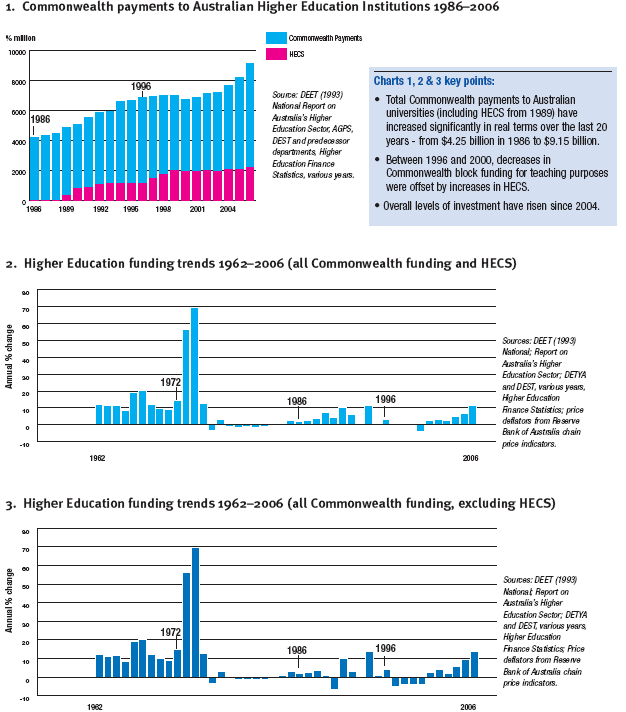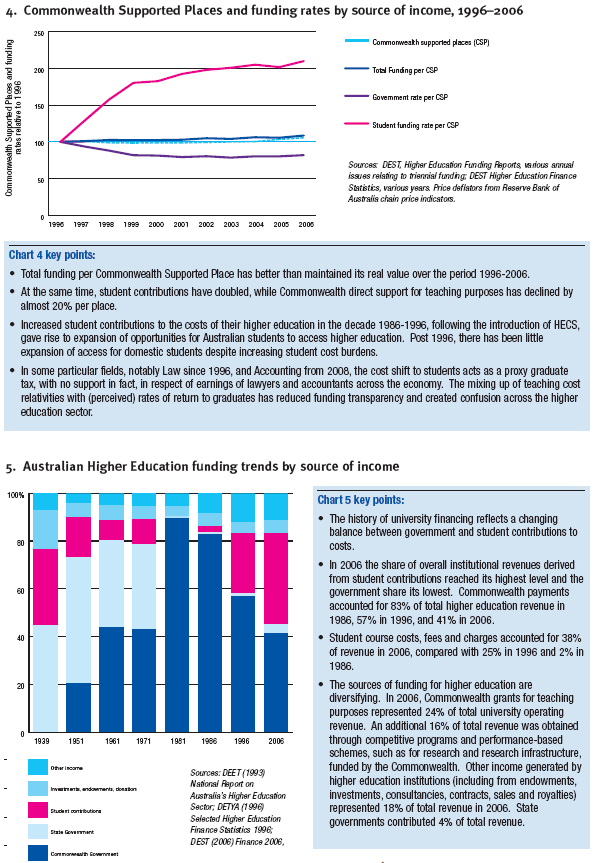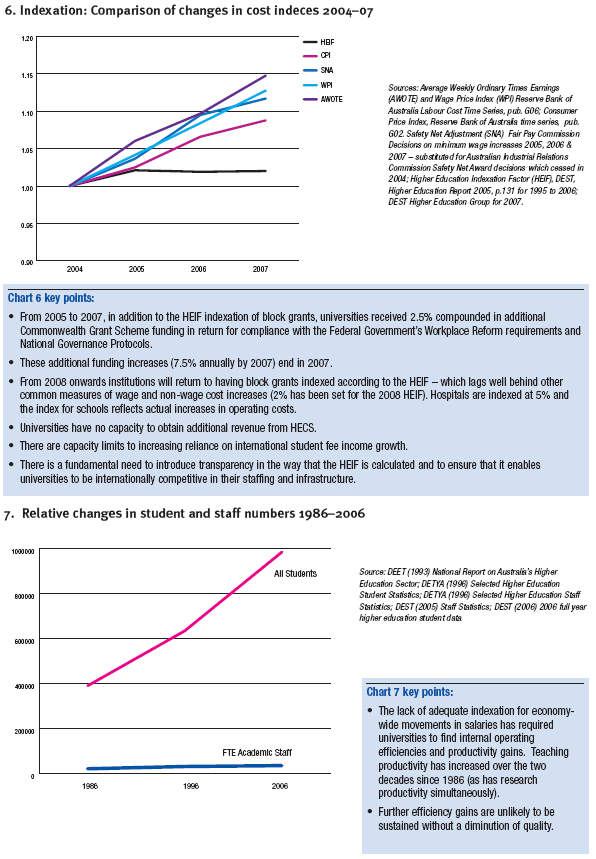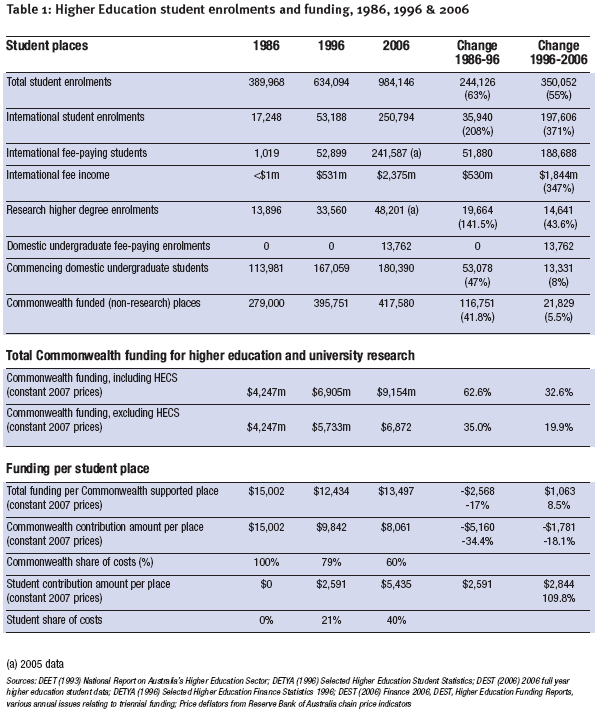|
Group of Eight Publishes Its Election Policy Wish List; What Response Will They Receive? |
|
Students the losers from outdated
funding policy Students are paying more for higher education but not benefiting as they should," according to Go8 Chair, Professor Alan Robson. "Following a decade of decline in the real rate of funding per student from 1986, total funding per student place has increased marginally in real terms over the last decade but mainly because of a doubling in student contributions through HECS increases. "Public funding per Commonwealth supported university place has declined by close to 20 per cent in real terms over the last decade. "With rising costs of university teaching and research, insufficient government funding is causing student staff ratios to blow out, putting intolerable pressure on the quality of the student learning experience as well as on staff. The Student/Staff Ratio has risen from 14.1 to 1 in 1986 to 19.1 to 1 in 2006, well above that of our main international competitors. The world's leading universities typically have ratios of less than 10 to 1. "For 2008 the indexation of government grants is set at 2.0% per annum. This is well below the rises in costs faced by universities. This level of indexation will undo the gains made since 2004 through additional public investment," he said. "Funding for teaching places takes no account of real costs, infrastructure needs, differences in student mix, regional circumstances or educational standards. "The problem is compounded for universities that have to cross subsidise under-funded research grants from their teaching budgets. "All this is occurring at a time when universities have their HECS prices capped and are at the limits of their capacity to absorb international students. "Current funding policies fail to give students the choices they need and the quality they expect. Current policies also fail to enable universities to respond to changing needs and sustain international competitiveness. "It is time for major rethinking of higher education policy and financing. If the problems in university funding policy are not tackled urgently, Australia will fall further behind the world's leaders. "To assist policy considerations the Go8 offers a new model of balanced incentives. Key proposals relating to the funding of higher education are set out below. "The Go8's proposals are designed to address the six basic problems with the current approach to higher education financing," Professor Robson said. Go8's proposed Higher Education policy solutions. The problems: Funding for higher education is 1. insufficient - there is no indication that future levels of public funding will be sufficient to sustain an internationally reputable standard of higher education; 2. inequitable - the student share of costs has risen disproportionately but with no apparent improvement in access or quality; 3. arbitrary - funding rates bear little relation to actual costs of teaching and funding decisions lack transparency; 4. inflexible - annual unit of study funding rates are too rigid, common rates of funding do not reflect differences in circumstances and they encourage sameness across the system rather than promote diversity and innovation; 5. bureaucratic -there are far too many specific purpose schemes, each with its own rules and restrictions, for which universities have to apply separately year on year and the central prescriptions make it harder for universities to make efficiency improvements; and 6. unresponsive - methods of funding pay too little regard to changes in student demand and labour market requirements. The solutions: 1. Adequate indexation of Commonwealth payments Provision needs to be made urgently for a new system of indexation of Commonwealth grants for Higher Education. The program of conditional increases in Commonwealth Grant Scheme payments (2.5% in 2005, 5% in 2006 and 7.5% in 2007) will provide no further growth in funding rates per student beyond 2007. HECS price limits have also been reached. All that remains is an arbitrary and opaque "Higher Education Indexation Factor" (HEIF) of 2.0% per year that bears no relation to actual movements in university operating expenses, provides far less than is needed to sustain quality, and falls short of indices for adjustment to cost changes adopted for other sectors. The Go8 suggests that the Education Wage Price Index be adopted, initially, as the basis for calculating the increase in Commonwealth grants for Higher Education, replacing the HEIF from 2009. For subsequent years a separate Higher Education Recurrent Resource Index should be developed, as exists for Commonwealth funding of schools. 2. Mission-based block funding of universities A major policy challenge is to recognise differences of mission and capability among universities and encourage each to focus on what it can do best. Universities should be funded through a program of rolling triennial block funding, to enable flexibility of operations, promote responsiveness to changing needs and provide some predictability for continuing programs. The composition of the block fund should be tailored for each university, reflecting their varying capacities, especially for research and research training, community service, and knowledge transfer. 3. Review of actual costs For future years, the Go8 proposes that the Productivity Commission should provide advice on actual and relative teaching costs by broad field of education. The Go8 envisages the study would consider cost differences across fields of higher education and have regard for differences in student mix, regional circumstances and learning standards. The study would provide contemporary information to guide a rebalancing of public and private cost shares, and increase transparency of funding allocations. 4. Universal entitlement to tertiary education loans Student access to undergraduate and graduate courses should be aided via a universal entitlement to an income-contingent loan and, for meritorious students and students from a low-income background, via national tuition scholarships. By these means higher education will be more responsive to market demand and less fettered by central government control. The current provisions of FEE-HELP should be available on request to all people who are accepted into a course of study leading to a higher education award. The Go8 envisages the loan component of HECS HELP being integrated with FEE-HELP into a single Tertiary Education Loan Scheme. 5. National scholarships for higher education courses The Go8 proposes that Commonwealth Grants Scheme payments, together with current funding for various scholarships, be integrated into a new national scholarships scheme. The scholarships would be portable to any accredited higher education institution in Australia, public or private, that meets accountability reporting requirements. These national scholarships would be awarded to individuals who merit them, with payment made to the institution at which the student enrols. Higher education institutions would be free to set their own prices for the courses they offer, with reference to the actual costs notified by the Productivity Commission. They could include or not include service packages (e.g. access to health & fitness facilities) as well as tuition in their offerings. The value of a scholarship to an individual would vary according to the course into which he or she is accepted. Where the scholarship value is lower than the course price the student would be able to borrow all or part of the gap through the Tertiary Education Loans Scheme. Higher education institutions would be able to offer price discounts to students on merit and equity grounds. The Government would have the ability to influence the shape of student demand by determining the number of scholarships to be awarded each year and the division of scholarships between school leavers and non-school leavers. Additionally, the Government may determine to put higher value weightings on some scholarships to encourage increased commencements into occupations of labour market shortage or to encourage the participation of under-represented groups. Debt waivers could also be offered to attract graduates to particular areas. |
To help inform the policy
debate, the Group of Eight offers the following analysis of higher
education funding trends in Australia.    |